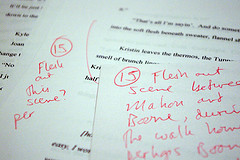Find a Working Method that Works for You
My current WIP novel is at a curious stage. I’ve finished two drafts and now have feedback from two readers. I collated all the critiques onto one printout and have made even more notes on these pages.
So, the creative writing problem has been how to proceed from here.

Retype. At first, I started retyping everything. While I’ve suggested this as one way of doing a drastic revision, I’m not ready for this yet. It did force me to reconsider every word, but it was too much at this stage.
New File. Next, I tried starting a new file for the revised version and just adding one chapter at a time. But I found myself afraid to revise in this file. I didn’t want to make mistakes in this new file, and the writing suffered from my aversion to trying new things.
Temporary File and New File. Finally, I started copying the next chapter into a temporary file and making revisions there. Only when I’m happy with the chapter will I copy it into the new revised file.
It may seem cumbersome to you, but I had to find a working method that would foster the creativity and freedom needed in this novel revision, while still keeping me moving steadily forward. The temporary file and new file combination just works.
Revisions are done in situ or not at all. Retyping is rewriting is why bother to write in the first place.
You should trust your immediate instincts when words flow because they are the right words. Revisions are used to change your true voice to one acceptable by the outside world.
Okay, so you want to be published and all that. Well, save your original draft. It will be valuable 100 years hence.